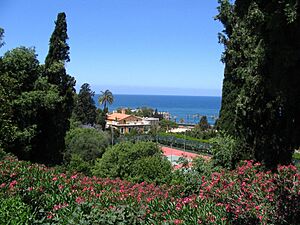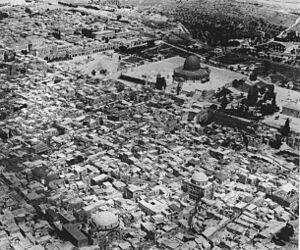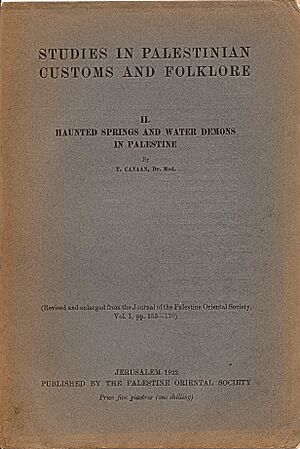Tawfiq Canaan facts for kids
Quick facts for kids
Tawfiq Canaan
|
|
|---|---|
 |
|
| Born | 24 September 1882 Beit Jala, Ottoman Empire
|
| Died | 15 January 1964 (aged 81) East Jerusalem, West Bank
|
| Nationality | Palestinian |
| Occupation | Physician, Ethnographer, author |
| Known for | Pioneer in the field of medicine in Palestine Researcher of Palestinian popular heritage |
| Parent(s) | Bechara Canaan and Katharina Khairallah |
Tawfiq Canaan (Arabic: توفيق كنعان) (born September 24, 1882 – died January 15, 1964) was a very important Palestinian doctor and researcher. He was also an ethnographer, which means he studied different cultures and peoples. He was born in Beit Jala when the Ottoman Empire ruled the area.
During World War I, he worked as a doctor for the Ottoman army. Later, when the British ruled Palestine, he became the first president of the Palestine Arab Medical Association in 1944. He also directed several hospitals in Jerusalem. Throughout his career, he wrote many studies on topics like tropical medicine, bacteriology, malaria, and tuberculosis. His research even helped find a cure for leprosy.
Tawfiq Canaan was very interested in Palestinian folklore, which includes old stories, beliefs, and superstitions. He collected over 1,400 amulets and special objects believed to have healing or protective powers. His writings about these objects and other traditions made him known as an ethnographer and anthropologist. His books and articles, written in English and German, are still valuable for people studying Palestinian and Middle Eastern history. He also wrote in Arabic and spoke Hebrew.
He was a strong public speaker and wrote two books about the problems in Palestine. These books showed his opposition to British rule and Zionism. The British authorities even arrested him in 1939. In his later years, he faced personal difficulties, including the loss of his son and the destruction of his home and clinic during the 1948 war.
After these events, Canaan rebuilt his life and career in East Jerusalem under Jordanian rule. He lived in a convent in the Old City for two years. Then, he became the director of the Augusta Victoria Hospital on the Mount of Olives. He lived there with his family until he retired and passed away in 1964.
Contents
Early Life and Education

Tawfiq Canaan was born in Beit Jala, a village in Palestine. This was during the time of the Ottoman Empire. As a child, he went to the Schneller School in nearby Jerusalem. This school was started by German missionaries.
His father, Bechara, also went to this school. Bechara founded the first Lutheran church, YMCA, and co-ed school in Beit Jala. He was also the first Arab pastor for the German Protestant Palestine Mission. Tawfiq's mother, Katharina, grew up in a German orphanage in Beirut. She met Bechara while working at a hospital in Jerusalem.
In 1898, Canaan went to Beirut to study medicine. He attended the Syrian Protestant College, which is now called the American University of Beirut. He had to work while studying because his father died shortly after he arrived. He graduated with honors in 1905. His graduation speech was about "Modern Treatment." It talked about new medical methods like using serums and X-rays.
Canaan believed his love for Palestine came from his childhood. His father often took the family on trips around the country. These trips helped him learn a lot about nature in Palestine. This knowledge showed up in his writings, like "Plant-lore in Palestinian Superstition" (1928).
Medical Career and Research

After finishing his studies in Beirut, Canaan returned to Jerusalem. He started working at the German Deaconesses Hospital in 1906. He also helped manage the German-Jewish Hospital, now called Shaare Zedek. His first medical article, "Cerebro-Spinal Meningitis in Jerusalem" (1911), was based on his studies there.
From 1912 to 1914, Canaan traveled to Germany several times. He wanted to learn more about tiny living things (microbiology) and diseases common in hot climates (tropical diseases). In Germany, he met his future wife, Margot Eilender, in an Esperanto class. Margot's father was a German importer, and she grew up in Palestine. They married quickly and had their first child, Yasma, that same year.
In 1913, they built their family home in the al-Musrarah area of Jerusalem. Their other three children were born there. Canaan also opened the only Arab clinic in Jerusalem at that time in their home.
He worked with German doctors, including Hans Müch. Canaan wrote three research papers for Müch's 1913 report on tuberculosis. That same year, Canaan became the director of the Malaria Branch of the International Health Bureau. This was a global center for medical research. He also treated patients at the Arab General Hospital near Jerusalem.
World War I and II Medical Service
When World War I started in October 1914, Canaan was working at the German Hospital in Jerusalem. As a citizen of the Ottoman Empire, he joined the Ottoman army as an officer. He was first a doctor in Nazareth, then moved to 'Awja al-Hafeer. He became the Head of Laboratories on the Sinai Front. This job allowed him to travel to many cities, including Gaza, Damascus, and Amman. During the war, he collected over 200 amulets for his collection. He got sick with cholera and typhus but survived. Sadly, his brother Wadia was killed in the war.
In 1919, after the war, Canaan became the director of The Leprosy Hospital in Talbiya. This was the only leprosy hospital in Syria, Palestine, and Transjordan. At that time, leprosy was thought to be incurable. Canaan's research in bacteriology helped discover a cure using chaulmoogra oil.
In 1923, the German Hospital reopened, and Canaan became head of the Internal Medicine Division. He held this position until 1940, when World War II began. Most German citizens had to leave Palestine or were arrested by the British.
Throughout his medical career, Canaan treated people from all walks of life in Palestinian and Arab society. He was a well-known doctor. For example, he was one of the doctors who examined Sherif Hussein of Mecca before he died in 1931. He was also mentioned in the book Famous Doctors in Tropical Medicine (1932).
Research on Palestinian Culture
Canaan was very interested in Palestinian farmers, called fellaheen. He gave a lecture in Arabic about "Agriculture in Palestine" in 1909. This lecture was later published in German in 1911. It is still a useful source for understanding Palestinian agriculture in the early 1900s. In this article, Canaan showed his deep knowledge of "Oriental Studies." He used old sources like the Bible to compare past and present farming methods.
In 1913, he wrote "The Calendar of Palestinian Peasants." This paper focused on traditional beliefs that guided farmers' practices. He noted that people in southern Palestine divided the year into seven periods of 50 days. Later scholars found that this calendar system was very old, dating back thousands of years.
Canaan's first book about Palestinian traditions was published in 1914. It was called Superstition and Popular Medicine.
Palestine Oriental Society
Canaan was an active member of the Palestine Oriental Society, founded in 1920. He was on the board and served as secretary and treasurer until 1948. He also published many articles in the Society's journal. These articles showed his strong interest in superstitions. Examples include "Haunted Springs and Water Demons in Palestine" (1920–1921) and "Plant-lore in Palestinian Superstition" (1928).
Experts like Salim Tamari describe Canaan as a leading "nativist" ethnographer. These researchers believed that the true "native culture of Palestine" was found in the traditions of the farmers. They felt it was important to record this ancient heritage quickly before modern life changed it. Other Palestinian ethnographers like Omar Saleh al-Barghouti and Stephan Hanna Stephan shared this view.
Mohammedan Saints and Sanctuaries
Canaan's book, Mohammedan Saints and Sanctuaries in Palestine (1927), is considered his most important work on Arab Palestine. In the book's introduction, Canaan explained why he felt it was urgent to document these traditions. He wrote that "The primitive features of Palestine are disappearing so quickly." He wanted to save these old beliefs and practices before they were forgotten due to Western influences.
His book describes the shrines (awlia) and sanctuaries (maqamat) that were part of popular Islam and local religion in Palestine. He also covered shared Christian, Jewish, and Muslim rituals. Canaan believed that many local saints were actually respected sheikhs who became saints after they died. He saw these practices as evidence that Palestinian farmers were following traditions from the very old inhabitants of Palestine.
The book also talks about healing rituals, like bathing in special water sources to cure illnesses. Canaan noted how people with fevers would drink from a cistern in Hebron or bathe in springs in Silwan. Certain swamps were also thought to have healing powers. For example, Al-Matbaa was famous for curing infertility and other pains.
Archaeology and Ethnography
Canaan knew many experts in Palestinian archaeology. His interest in the region's history naturally included archaeology. In 1929, he joined an archaeological trip to Petra. There, he discovered an ancient shelter. That same year, he published an article called "Studies in the Topography and Folklore of Petra." It included maps with Arabic names for places, which he learned from local Bedouin people. He also wrote about the Lijatne tribe, explaining that their unique hairstyles were just a recent fashion, not a sign of being an ancient tribe.
Nationalist Writings
Canaan's strong political views and sense of nationalism are clear in two of his books: The Palestine Arab Cause (1936) and Conflict in the Land of Peace (1936).
The Palestine Arab Cause was a short book published in English, Arabic, and French. It was a collection of articles Canaan wrote after the 1936 Arab revolt. Canaan described British policies in Palestine as harmful to Arabs. He questioned laws that prevented Palestinian immigrants from getting citizenship. The British authorities saw his writings as rebellious.
Conflict in the Land of Peace was written to respond to someone who claimed Jewish immigration helped Palestine. Canaan looked closely at these claims. For example, he agreed that Zionist settlers helped control malaria by draining swamps. But he pointed out that Arab workers did the hard work. This made the land more valuable for the Zionist owners. He also noted that Palestinians themselves drained swamps in many places to improve their own lands.
Canaan also signed a document sent to the Arab Higher Committee in 1936. He strongly disagreed with British policies, especially the policy of Jewish immigration to Palestine.
Published Works
(Partial list)
Folklore and Ethnography
- Agriculture in Palestine (1909)
- Demons as an Aetiological Factor in Popular Medicine (1912)
- The Calendar of Palestinian Peasants (1913)
- Superstition and Popular Medicine (1914)
- Haunted Springs and Water Demons in Palestine (1921)
- Byzantine Caravan Routes in the Negev (1922)
- Folklore of the seasons in Palestine (1923)
- Tasit ar-Radjfeh ("Fear Cup") (1923)
- Mohammedan Saints and Sanctuaries in Palestine (1927)
- Plant-lore in Palestinian Superstition (1928)
- Belief in Demons in the Holy Land (1929)
- Studies in the Topography and Folklore of Petra (1932)
- Light and Darkness in Palestine Folklore (1931)
- Unwritten Laws Affecting the Arab Women of Palestine (1931)
- The Palestinian Arab House, Its Architecture and Folklore (1933)
- Arabic Magic Bowls (1936)
- The Saqr Bedouin of Bisan (1936)
- The Decipherment of Arabic Talismans (1937, 1938)
- Superstition and Folklore about Bread (1962)
- The 'Azazme Bedouin and Their Region (1999, translated from German)
Politics
- The Palestine Arab Cause (1936)
- Conflict in the Land of Peace (1936)
Medical
- Modern Treatment (1905)
- Cerebro-Spinal Meningitis in Jerusalem (1911)
- Observations on an epidemic of dengue fever in Jerusalem (1912)
- The Oriental Boil: An Epidemiological Study in Palestine (1929)
- Kalazar in Palestine (1937)
- Topographical studies in leishmaniasis in Palestine (1945)
- Intestinal parasites in Palestine (1951)
Challenges During War
Family Arrests
Tawfiq Canaan was arrested by the British authorities on September 3, 1939. This was the same day Britain and France declared war on Germany. He was held for nine weeks in Acre. His wife, Margot, and his sister, Badra, were also arrested. They were held in a women's prison in Bethlehem. Margot was held for nine months, and Badra for four years. Later, they were moved to a detention camp until their release in 1943.
Margot was arrested mainly because of her German background. However, both women were active in politics. They helped start the Arab Women's Committee in Jerusalem in 1934. This group took strong political stands, calling for civil disobedience and continuing the general strike that began the 1936 revolt. Badra also helped the Palestinian group at The Eastern Women's Conference in Cairo in 1938. These arrests were part of the British effort to stop Palestinian resistance to British rule.
Arab Medical Society of Palestine
The Arab Medical Society of Palestine was created in August 1944. Canaan was its first president. He also helped edit the Society's journal, "The Palestinian Arab Medical Journal," which first came out in 1945. The Society also organized medical conferences.
As the situation in Palestinian cities became unsafe, the Society trained medical teams. These teams provided help to civilians and fighters. They worked with the Red Cross to protect hospitals. They also asked other medical groups for help, and some aid came from the Arab world. Canaan was also a founder of the Higher Arab Relief Committee, set up in 1948 to manage aid coming into the country.
The Nakba
On February 22, 1948, bombs and mortar shells hit Arab homes in the al-Musrarah area of Jerusalem. This is where the Canaan family lived. The children were moved to a safer place. But Tawfiq, Margot, Badra, and Nora (his sister-in-law) stayed. Their house was directly hit on May 9, 1948. The whole family then moved to a convent in the Old City. They lived there for two and a half years.
Canaan's family home, his library, and three books he was ready to publish were all destroyed. Luckily, his collection of amulets and icons was saved. He had given it to an international organization in the western part of Jerusalem for safekeeping earlier that year.
Awards
- Order of the Red Crescent (during World War I)
- Iron Cross of 1914
- Holy Sepulchre Cross with a red ribbon (1951)
- Order of Merit of the Federal Republic of Germany (1951)
See also
 In Spanish: Tawfiq Canaan para niños
In Spanish: Tawfiq Canaan para niños
- Saint George Interfaith shrine
- Palestinian Christians


